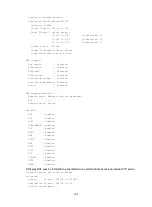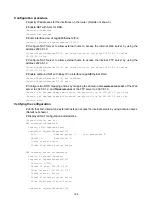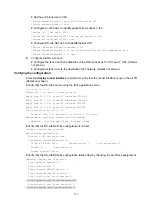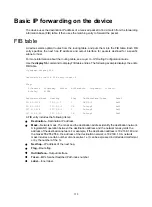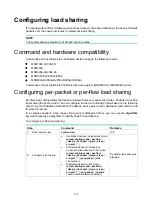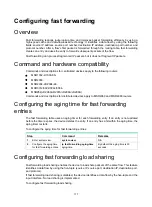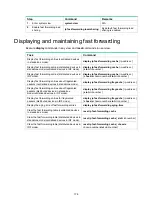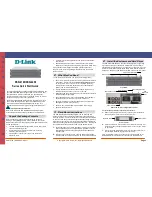
180
Displaying the adjacency table
Overview
The adjacency table stores information about directly connected neighbors for IP forwarding. The
neighbor information in this chapter refers to non-Ethernet neighbor information.
This table is not user configurable. The neighbor information is generated, updated, and deleted by
link layer protocols through negotiation (such as PPP dynamic negotiation) or through manual
configuration (such as ATM static configuration). An adjacency entry includes the following
information:
•
Neighbor network layer address (next hop).
•
Output interface.
•
Link layer protocol type.
•
Link layer address. This field displays PVC for ATM, and it is not available for PPP.
When forwarding an IP packet, the device performs the following tasks:
•
Searches the FIB to find the output interface and next hop.
•
Uses the output interface and next hop address to search the adjacency table for link layer
forwarding information.
NOTE:
Ethernet and non-Ethernet neighbor information are stored and managed together.
The following table shows the items in an adjacency table output:
Item Description
IP address
IP address of the next hop in FIB table. This address is used for adjacency
table lookup.
IPv6 address
IPv6 address of the next hop in FIB table. This address is used for
adjacency table lookup.
Routing interface
Output interface in the matching route entry. This interface is used for
adjacency table lookup, and it can be logical or physical.
Physical
interface
Output physical interface that sends matching packets.
•
If the routing interface is physical, the routing interface and physical
interface are the same.
•
If the routing interface is logical, the routing interface and physical
interface are different.
Logical
interface
Logical interface for sending packets, such as a virtual-Ethernet interface
for ATM, or a Virtual-Template interface for MP.
Service
type
Link layer protocol type, such as PPP or HDLC.
Action
type
Action to be taken on the matching packet:
Forwarding
or
Drop
.
Link
media
type
Related to the link layer protocol used by the routing interface.
•
P2P
—Point-to-point link.
•
NBMA
—Non-broadcast multi-access link.
Link
head
information(IP)
Link layer header for IP forwarding.
Link
head
information(IPv6)
Link layer header for IPv6 forwarding.

